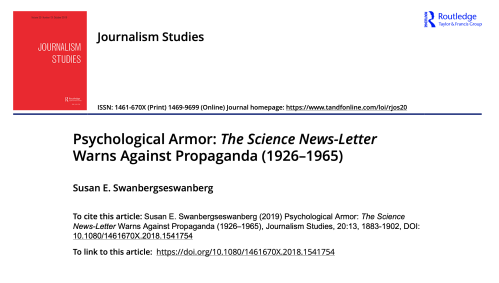
Category Archives: Academic articles
Comments Off on
Filed under Academic articles
“Well-Bred and Well-Fed” The Science Service Covers Eugenics: 1924 to 1966
Comments Off on “Well-Bred and Well-Fed” The Science Service Covers Eugenics: 1924 to 1966
Filed under Academic articles, Journalism Research
“Borrowed Chronicles: William L. ‘Atomic Bill’ Laurence and the Reports of a Hiroshima Survivor” in Legacies of the Manhattan Project: Reflections on 75 Years of a Nuclear World (ed. Michael Mays)
Comments Off on “Borrowed Chronicles: William L. ‘Atomic Bill’ Laurence and the Reports of a Hiroshima Survivor” in Legacies of the Manhattan Project: Reflections on 75 Years of a Nuclear World (ed. Michael Mays)
July 31, 2020 · 3:33 pm‘The Way of the Rain’: Towards a Conceptual Framework for the Retrospective Examination of Historical American and Australian ‘Rain Follows the Plow/Plough’ Messages
e
Abstract
History establishes that even before the advent of modern media, erroneous climate messages were disseminated to the public. A folk belief captured by the phrase ‘rain follows the plow’ (RFTP) is a prime example of such misinformation. This belief, popular in the late nineteenth century, maintained that cultivation of arid lands in the United States beyond the 100th meridian west would boost precipitation, creating a climate more favourable for farming. Encouraged by this narrative, homesteaders cultivated arid lands west of the meridian. Rain did not follow the plough and many farms in the Great Plains failed. RFTP was also invoked in South Australia in support of agricultural settlement north of Goyder’s Line, a geographical boundary delineating the limits of reliable rainfall in the colony. This article revisits the origins of the doctrine and places RFTP messaging in its historical context by examining articles and poetry published in American and Australian settlement-era newspapers. The results of two newspaper database surveys reveal that a number of historical RFTP stories and an environmental poem with religious overtones appeared first in US newspapers and were later republished in newspapers throughout Australia. One of the surveys also reveals that, from 1876 to 1898, reports of parliamentary discussions or debates referencing the slogan were published in South Australia. The dissemination of inaccurate climate information in settlement-era America and Australia is discussed in relation to a proposed conceptual framework based upon contemporary theories of science communication that might provide a basis for the analysis of historical science messaging.
Keywords: climate, rain follows the plow/plough, 100th meridian, Great Plains, Goyder’s Line, Charles Dana Wilber, Samuel Aughey, science communication, United States, South Australia
Comments Off on ‘The Way of the Rain’: Towards a Conceptual Framework for the Retrospective Examination of Historical American and Australian ‘Rain Follows the Plow/Plough’ Messages
Filed under Academic articles
Psychological Armor: The Science News-Letter Warns Against Propaganda (1926-1965)

ABSTRACT
The Science Service, established in 1921 by newspaper magnate, Edward Willis “E.W.” Scripps, and zoologist, William E. Ritter, was founded to educate the public about science. The overarching aims of the Service were to instill in the public a scientific habit of mind and improve the public’s critical thinking skills, thereby strengthening democracy. The Service acted as a liaison between scientists and the public by disseminating accessible scientific information through a variety of media, including The Science News-Letter. Service founders maintained that the agency would not promulgate propaganda “unless it be propaganda to urge the value of research and the usefulness of science.” Between the first and second world wars, the Service began an anti-propaganda campaign in its newsletter; cautioning readers about the dangers of propaganda, describing how to recognize propaganda, and explaining how to defend against it – providing the public with “psychological armor” in the words of Science Service writer, Marjorie Van de Water. Between 1926 and 1965, 187 newsletter articles included the keyword “propaganda.” This essay identifies, examines, and places in context, newsletter articles on propaganda and argues that, in spite of the organization’s stated mission, aspects of its counter-propaganda crusade veered into the realm of propaganda.
Key words: E.W. Scripps; Marjorie Van de Water; propaganda; science journalism; Science Service; The Science News-Letter; William Ritter
Psychological Armor The Science News Letter Warns Against Propaganda 1926 1965
Comments Off on Psychological Armor: The Science News-Letter Warns Against Propaganda (1926-1965)
Filed under Academic articles
Wounded in Mind:Science Service Writer, Marjorie Van de Water, Explains World War II Military Neuropsychiatry to the American Public

Abstract
Marjorie Van de Water covered psychology and sociology for Science Service, an American news organization for the popularization of science. During her tenure as a writer for Science Service, Van de Water reported about developments in American military neuropsychiatry, wartime morale, and related topics. Her articles appeared in a Science Service publication, The Science News-Letter, and in mainstream American newspapers. In 1942, Van de Water was recruited to collaborate on Psychology for the Fighting Man, a military-sanctioned basic psychology book for World War II service members. Van de Water also contributed to two additional books on wartime psychology—Psychology for the Returning Serviceman and Psychology for the Armed Services, a military neuropsychiatry textbook. This article examines Van de Water’s acknowledged body of work on military neuropsychiatry and her dual roles as a Science Service journalist and an interpreter of American military neuropsychiatric policy.
KEYWORDS: Marjorie Van de Water, Science Service, The Science News-Letter, World War II, military neuropsychiatry, E.W. Scripps
Comments Off on Wounded in Mind:Science Service Writer, Marjorie Van de Water, Explains World War II Military Neuropsychiatry to the American Public
Filed under Academic articles



